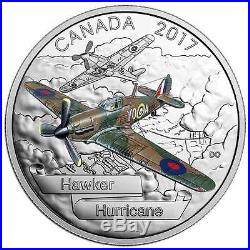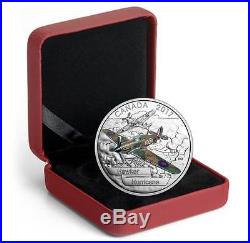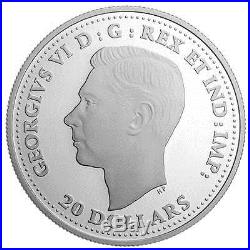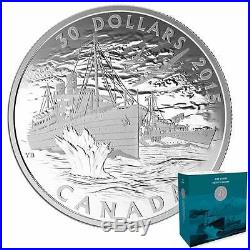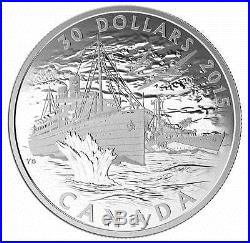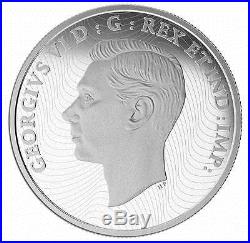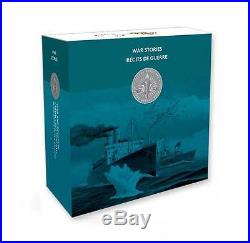2015 Merchant Navy in the Battle of the Atlantic 2oz Silver. Price includes all Eurozone import and VAT charges – last unit left. The Battle of the Atlantic was not won by any navy or air force, it was won by the courage, fortitude and determination of the British and Allied merchant navy. Rear Admiral Leonard Murray, Commander-in-Chief Canadian North Atlantic. From its very onset in September 1939, the Second World Wars longest continuous military campaign was fought in the waters of the Atlantic Ocean. During six long years of naval warfare, enemy U-boats and warships targeted Allied transport ships in an attempt to cut off vital Allied supply lines between Europe and North America. A decisive Nazi victory at sea could have starved Great-Britain into submission but Canadas Merchant Navy would play a central role in maintaining this Atlantic lifeline, which provided much-needed personnel, food, fuel and weapons to the Allied cause in Britain and beyond. While the Royal Canadian Air Force (RCAF) could offer protection by air as far as its planes could travel, the Royal Canadian Navy (RCN) oversaw the placement of these ships into convoys; these column formations were then escorted by armed naval escorts. This perilous transatlantic journey carried great risk for the merchant mariners who served in Canadas fleet of transport ships. Knowing that their non-military vessels were key targets, they nonetheless carried out voyage after voyage, transporting vital supplies and dangerous cargo around the world through treacherous ocean passages and harsh conditions, ever vigilant of the constant enemy threat from above or below. At first, the Allies suffered devastating losses as U-boats were relentless, operating in groups (or wolf packs) to torpedo convoy ships. Many of these ships were lost in the North Atlantic, in an area nicknamed the black pit that was beyond the reach of Allied aircraft; others were sunk off the shores of South America and Africa. It also brought the war to Canadian shores as several ships fell prey to attack in Canadian waters, leading to the temporary closure of the St Lawrence River and Gulf of St. In the spring of 1943, the tide began to turn; Canadas shipbuilding industry was turning out new ships (including the famous corvettes), and Allied escort ships were better equipped and manned with experienced crews. Fast ships were positioned to come to the aid of a threatened convoy; small flight decks were added to merchant ships, allowing three or four aircraft to serve as additional defence and British Intelligence had finally cracked the secret code used by U-boat commanders. The Battle of the Atlantic continued on for two more years, until the very end of the war. Merchant ships made more than 25,000 voyages between 1939 and 1945, delivering 165 million tonnes of cargo overseas. In spite of the perilous task at hand, the heroism of these 12,000 Canadian men and women made an immeasurable contribution to the Allied war effort at home and abroad, and has left a proud legacy for all Canadians to remember. We think with special gratitude of the many merchant seamen who have fallen in the fight and whose service and sacrifice will always be a proud memory. Lord Leathers, Ministry of War Transport. Coin Metal: 9999 pure silver. Year of Issue: 2015. Coin Mintage: 5,000. Country of Issue: Canada (Royal Canadian Mint). The reverse design by Canadian artist Yves Bérubé features an impeccable combination of expert engraving and beautiful finishes and depicts the dangerous conditions endured by transatlantic ships during the Battle of the Atlantic between 1939 and 1945. It is a calm evening on July 11, 1943; in the foreground, the ocean steamer. SS Duchess of York. (left) is featured prominently, with a thick plume of steam billowing out from its funnels. Requisitioned as a troopship during the war, the large vessel is part of the convoy dubbed Faith, which has been spotted by enemy aircraft off the coast of Spain. Two Focke-Wulf Fw-200 Kondors have begun their high-level bombardment, with one bomb hitting the water starboard side off the ships bow, where detailed engraving adds movement through the motion of the waters surface. One of the convoys escort ships, the Tribal-class destroyer. (right), has unleashed anti-aircraft fire but it is all in vain against this airborne attack. And 34 of its crew would be added to the Allied casualties suffered during the Second World Wars Battle of the Atlantic, 628 of its survivors would be rescued and transported to safety by. Did you know Merchant ships made more than 25,000 voyages between 1939 and 1945, delivering 165 million tonnes of cargo overseas in convoy formations that were defended by armed naval escorts. On June 15, 1940, the. Attacks took place in the waters of the Caribbean and along the eastern seaboardincluding the Gulf of St. Lawrence, which led to the closure of the St. U-boats engaged in a wolf pack tactic of congregating as a group in the path of an oncoming convoy, then unleashing a mass attack to overwhelm the escort ships. Losses in the Battle of the Atlantic reached their peak in March 1943. Two months later, in May 1943, Allied forces turned the table destroying more than two dozen U-boats, forcing their temporary withdrawal from the North Atlantic; May 1943 is thus celebrated as the turning point of the Battle of the Atlantic. The range reached by Allied aircraft was limited during the early years, leaving convoys without an air escort for part of the journey; flight decks were later added onto merchant ships to create Merchant Aircraft Carriers (MACs) that would allow them to carry three or four aircraft for added airborne defence. When war was declared, Canada had 38 ocean-going merchant vessels; by 1945, Canadas shipyards had built 410, at a peak rate of almost two merchant ships per week in 1944. Canadas dedication to creating a merchant fleet made it the 4th largest during the war. The obverse features the effigy of King George VI by T. Your coin is encapsulated and presented in a Royal Canadian Mint-branded maroon clamshell with graphic beauty box. The item “2015 Merchant Navy in the Battle of the Atlantic 2oz Proof Silver Coin” is in sale since Wednesday, January 03, 2018. This item is in the category “Coins\Coins\World\Canada”. The seller is “minted-uk” and is located in Essex. This item can be shipped worldwide.
- Region of Origin: Central America & Canada
- Country: Canada
- Year of Issue: 2015
- Country/Region of Manufacture: Canada
